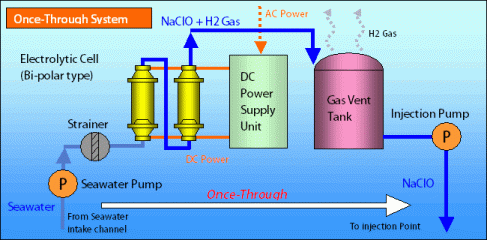Chlorination began in the early 1900’s and since then diseases such as dysentery, cholera, and typhoid have significantly decreased to almost 0% in 1950. It was a very impressive discovery with tremendous affects on sociey. Since then, electrochlorination is a newer more updated way to treat drinking water. It does not harm the environment and does not have any by-products like basic chlorination has. It is much safer to handle, is nontoxic, relatively easy to make and is a more natural way to treat drinking water.
Electrochlorination runs an electrical current in salt water to produce hypochlorite. It is considered to be a type of desalination and is a rather simple process. Saltwater is put into electrolyzer cells (after solids are removed). It is then moved through various channels that range in decreasing thickness and are charged with positive and negative low current DC. The reaction is a production of sodium hypochlorite and hydrogen gas, which has between 0.7-1% chlorine. It uses chlorine, a very common drinking water disinfection, in a hypochlorate solution that is dispersed within the system. The hydrogen gas is then removed and the solution is stored. It uses no chemicals!!
Electrochlorination follow this simple equation:
NaCl + H2O + Energy -> NaOCl + H2
Electrochlorination systems are usually used by large water utility companies before the water is pumped to households, but it is becoming more available to smaller populations and there are several installation engineering companies that design specifically for the clients needs .
It has several advantages:
- Low costs
- Used worldwide
- Nontoxic because it is salt based
- Easy to store
- Safe to produce
- Low maintenance
- Long life cycle
- Approved as a disinfection from the CDC
- Reduces scaling because of a lower pH
Disadvantages are:
- Effects biofilm in hot water pipes and tanks
- Effect on bacteria is limited in the long term
- Smell and taste is changed
- Less effective with pH’s higher than 7.5

NOT too bad huh?!

